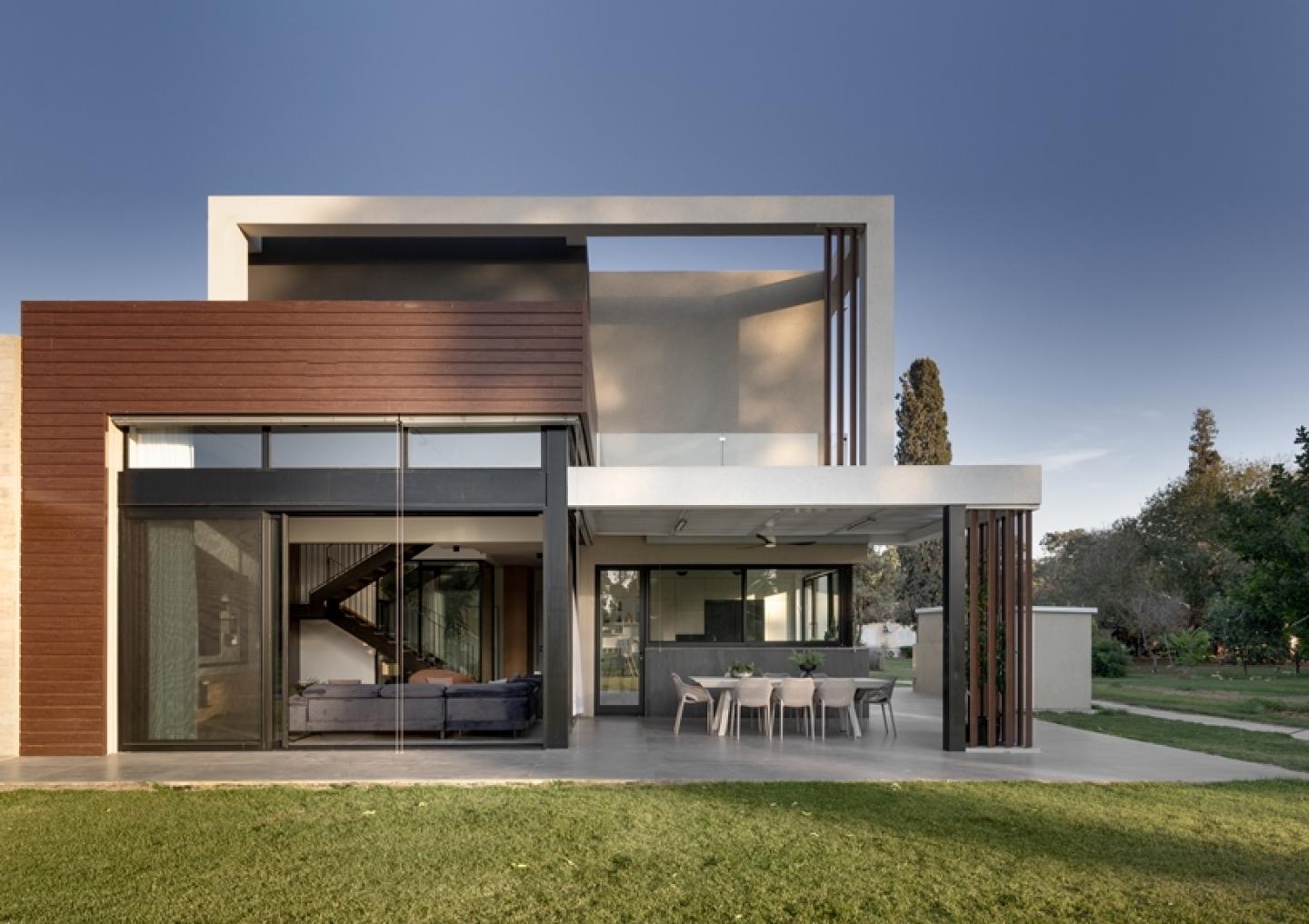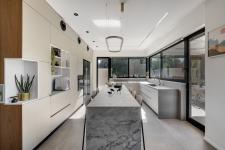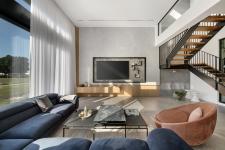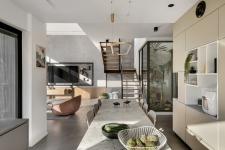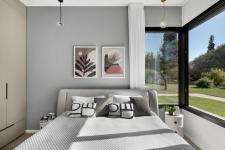Exquisite architecture and meticulous design have, in recent years, become an important focus for many Israelis, regardless of where they are located in the country. This property, which is located in Kibbutz Kfar Masaryk in the western Galilee, was planned and designed for a hi-tech professional couple by the esteemed architect, Adi Aronov, and is a great example of this recent trend.
After years of living in a small standard Kibbutz property, the couple won the bid for this plot, and their dream was to build an elegant and spacious home, entirely different from the Kibbutz standard. As such, they wished to work with an architect who would make this dream a reality by breaking conventions and creating a home that would be a “game changer” in its surroundings. That was when architect Aronov came into the picture. The architect masterfully and considerately created a cozy, spacious, and bright home that despite being different from the norm, still blends harmoniously with its surrounding nature.
“The connection between the clients and I was anything but obvious”, says Aronov. “Most of my projects are located in central Israel and are more often than not, regular properties. In this case, the plot we had to work with came with many restrictions. The clients came to me after spending considerable time and effort sourcing a local architect, as they couldn't find a professional whose projects they found sufficiently inspirational”. According to the architect, at some point, they read an article that listed the top 20 architects in the country, and this was how they found her. She continues: “As soon as I realized that this was a Kibbutz-based project, I had to politely decline. However, the clients’ determination to create an unusual and unique property truly impressed me, and so the rest was history”. Aronov recalls the strong connection that was established with the clients during their very first meeting, which was, according to her, the first step in the journey. “The process was not a smooth one by any stretch of the imagination: in the follow-up conversation I had with the clients, they advised me that the plans would need to be reviewed and vetted by the Kibbutz committee, which was rather discouraging, but due to the relationship with the clients and since I enjoy a professional challenge, we decided to just go for it!”, she adds with a smile.
And so, the journey began and practically every step of the project was subject to various reviews, committees and approvals: “We were reviewed by a committee that was run by five different bodies, during which the clients and I were asked a long list of questions, the plans and budget were analyzed in details, and every stage of the works required the Kibbutz committee review and approval, down to the choice of materials. As a result of the lengthy process, the project took four years to complete”, says Aronov.
It appears, however, that the results were worth the wait: the property represents the changes that the Kibbutz system had undergone in recent years, where instead of standard cookie-cutter housing that is based on the foundations of all being equal, new and diverse properties have started to pop up. Aronov’s project is by far the most extreme “game changer”: daring, unique, and unusual even in comparison to the newer builds.
The east-facing facade, which overlooks a cluster of old-build properties, was modestly designed to ensure it blended in the traditional Kibbutz scenery: “This is the main entrance to the property and was intentionally planned to be simple with a ‘kibbutz’ feel so that it would blend in its surroundings”, explains the architect. “Whilst the east-facing main entrance is mostly used by visitors, I created another entrance on the western side that serves the family on a daily basis - where they park their car and bicycles. The entrance overlooks an endless green view making the connection between the interior and exterior practically seamless”.
The west facing facade tells a story that is very different from that told by the traditional Kibbutz norm. In order to create a sense of space and ensure plenty of natural daylight, Aronov created a frame that runs the entire external length of the property. The louvered ventilation and shading panels,shaped like airplane wings, give a sense of volume and space, complement the frame, and give the property a dynamic feel. Thin gray tiles, that blend with similar colored elements in the interior, were used below the windows.
The living room looks like a cube from the outside and was covered in wood-like aluminum panels. Large concrete looking tiles were used for paving and are identical to those used for the interior, giving the outdoor and indoor spaces a sense of continuity. “The structure’s frame has a life of its own, it follows the entire structure like a freehand sketch”, explains the architect. “Gray and beige were used for the facades alongside the white dominant frames, creating a play between the exposed and the concealed”.
An impressive bespoke carpentry unit, designed by Aronov, runs from the entrance to the kitchen, concealing a door that leads to the parent’s master suite. Across from it is a rectangular carpentry cube behind which one of the children’s rooms is located - the rationale was to ‘direct’ visitors away from the bedrooms located by the main entrance and visually guide them to the beautiful patio further along the corridor.
“The house was built in a way that the bedrooms are the first rooms that greet visitors”, explains Aronov. “Thus, in order to conceal them and turn the corridor into a design element, we created bespoke carpentry pieces that are used both for functional storage and as an elegant passage to the ground level”. The eyes are thus drawn to the space rather than the actual bedrooms. The patio brings the outdoors into the house - a repeating motif throughout the property. “Since Kibbutz protocols restrict plots in terms of their garden space, and the clients wanted to create their own little corner of nature, we decided to bring the pastoral outdoors into the home so that the greenery, daylight, and breeze are an integral part of it throughout the day”, the architect adds.
The carpentry wall runs up to the kitchen ending in a niche that blends naturally with the space. The wood softens the champagne-colored stainless-steel kitchen cabinets, which were dotted with white-gloss storage cubes to lighten the overall mass.
Gray marble with delicate veining that creates a sense of movement, was used for the island worktop and an oval lighting fixture was fitted above it to balance the square space. There are no walls in the kitchen, instead, the architect planned large dark profiled windows that let in plenty of soft daylight and overlook endless greenery.
Maximizing natural daylight throughout the property guided Aronov during the planning stages: “I treated the sun as a lighting fixture”, she explains. “I studied the sun’s position in relation to the property throughout the day in detail, and how this impacted each and every space at any point in time. I used this as the foundation for planning the various sized and shaped openings to ensure as much natural light as possible, whilst also opening the interior up to the skies, the greenery, etc.“
Large windows that overlook the glorious view replace walls in the living room too and create a sense of lightness and spaciousness. Together with a 4.5-meter-high ceiling, it feels as though one might be standing in the open nature rather than in a built structure.
The tv wall, which is essentially the only fully built wall in the space, was covered in delicately veined light tiles with a black framed tv mounted in its central niche. Large thin terrazzo-style tile cladding covers the niche, adding flair to the living room.
Minimalist shelves were put up around the tv in a composition that resembles the structure’s dominant exterior frames, and at the bottom of the wall a wooden chest of drawers was placed, adding a touch of warmth.
Aronov chose a deep and particularly comfortable navy velvet sofa for the living room, ideal for entertaining. To the clients’ request, this was matched with a dusty pink loveseat that completes the look. “Sitting in the lounge allows one to enjoy all that this property has to offer - a patio, open skies, green surroundings, and a staircase that leads up to the top floor. Thanks to the windows and high ceilings, there is a sense of height that is almost spiritual and larger than life. It is definitely not what you would expect from a typical kibbutz property”, says the architect.
A guest toilet with a shower was planned on the ground floor, with the forward-thinking view that once the eldest child grows up, he would benefit from having a dedicated bathroom within close proximity to his bedroom. The large glossy black tiles chosen by Aronov, reflect the patio and create the illusion of daylight in the windowless space.
The wonderful flow between the interior and the exterior continues in the master bedroom where the greenery can be seen in all its glory each and every morning. Across from the bed is a cupboard that upon first glance looks like wall cladding dotted with cubes. Parquet floors add warmth to the room and create a sense of intimacy. To save space, Aronov created a pocket door that leads to the en-suite bathroom. The taps and shower head, like the lighting fixtures throughout the property, are gold and resemble dainty jewelry pieces that decorate the space.
The top level is accessed via a steel staircase with floating wooden treads that create a delicate and airy feel. A space at the top of the stairs was created with the view to serve as a family corner in the future, with several openings that allow plenty of natural daylight, blue skies, and nature to embrace the space. The top level includes two children’s bedrooms, each of which enjoys a feature wall in a dominant color chosen by the children themselves, who also chose the artwork and curtains. Their bathroom is unusual, to say the least, with black marble floors and veined white marble walls. The golden taps that appear here too add to the luxurious bold look and continue the property’s design theme.
"This project was a long journey, which involved much bureaucracy. However, the results are simply breathtaking - this property is an absolute gem in this old Kibbutz - it adds character, style, and courage to the place. We live in times where people are exposed to a variety of styles with endless design options, which means they can turn their dreams into reality with the homes they build. This, in turn, is impacting the standards of architecture in such locations, and therefore this property can be seen as the manifestation of a very welcomed change”, summarizes Aronov.
2022
2023
-
architect Adi Aronov
